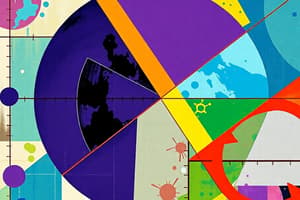Podcast
Questions and Answers
What is the formula to calculate the circumference of a circle?
What is the formula to calculate the circumference of a circle?
- C = 2r
- C = πr
- C = 3πr
- C = 2πr (correct)
How is the sum of angles in any triangle related?
How is the sum of angles in any triangle related?
- The sum is 180 degrees (correct)
- The sum is 360 degrees
- The sum is 270 degrees
- The sum is 90 degrees
What are points, lines, and planes considered in geometry?
What are points, lines, and planes considered in geometry?
- Unrelated concepts
- Fundamental building blocks (correct)
- Complex figures
- Advanced algorithms
What does the formula (n-2)*180 represent in geometry?
What does the formula (n-2)*180 represent in geometry?
How are circles defined geometrically?
How are circles defined geometrically?
What do Sine, Cosine, and Tangent represent in trigonometry?
What do Sine, Cosine, and Tangent represent in trigonometry?
What does the Pythagorean identity state?
What does the Pythagorean identity state?
How is the Unit Circle used in trigonometry?
How is the Unit Circle used in trigonometry?
In geometry, what are some examples of three-dimensional figures mentioned?
In geometry, what are some examples of three-dimensional figures mentioned?
How are transformations related to geometry?
How are transformations related to geometry?
Study Notes
Exploring Mathematics: Geometry and Trigonometry
Mathematics, a subject that has captivated minds and shaped the world through its precise logical structure, encompasses various disciplines such as algebra, calculus, and two of its most visually exciting and interconnected areas: geometry and trigonometry.
Geometry
Geometric math delves into the study of shapes, size, position, and the relationships between them. This field is as old as humankind's fascination with the world's intricate patterns and proportions.
Key concepts in geometry include:
-
Points, Lines, and Planes: The fundamental building blocks of geometry, points are locations in space, and lines are the paths connecting them. Planes are flat, two-dimensional surfaces that extend infinitely in all directions.
-
Angles: The measure of the space between two lines meeting at a point. The sum of angles in any triangle is 180 degrees, and the interior angles of any polygon can be calculated using the formula (n-2)*180, where n is the number of sides.
-
Circles: A set of points equidistant from a given point, known as the center. A circle's diameter is twice its radius, and a circle's circumference is calculated using the formula C = 2πr, where C is the circumference and r is the radius.
-
Area and Volume: The measure of the space enclosed or occupied by a geometric figure. The area of common shapes, such as squares, rectangles, or circles, can be calculated using specific formulas, as can the volume of three-dimensional figures like cylinders, cubes, or cones.
-
Transformations: The movement or manipulation of geometric shapes, such as translations, rotations, reflections, and dilations.
Trigonometry
Trigonometry, an extension of geometry, explores the relationships among the sides and angles of triangles. This field is rooted in the ancient world, with the invention of trigonometric functions attributed to Greek mathematicians Hipparchus and Euclid.
Key concepts in trigonometry include:
-
Sine, Cosine, and Tangent: Three trigonometric functions representing the ratio of the length of a side of a right triangle to the length of its hypotenuse (sine), its adjacent side (cosine), or its opposite side (tangent) for a specific angle.
-
Unit Circle: A circle with a radius of 1, which is used to define the trigonometric functions by their x and y coordinates in a right triangle contained within the circle.
-
Angles and Trigonometric Functions: The sine, cosine, and tangent functions are used to define the relationship between the sides and angles of a right triangle.
-
Trigonometric Identities: Mathematical relationships between trigonometric functions, such as the Pythagorean identity (sin²θ + cos²θ = 1) and the double-angle identity (sin(2θ) = 2sinθcosθ).
-
Applications of Trigonometry: Trigonometric functions are used in various fields, such as astronomy, physics, engineering, and architecture, to solve problems involving angles and side lengths, calculate distances on Earth's surface, and design structures like bridges and buildings.
As geometry and trigonometry intersect, they provide a deeper understanding of the relationships and connections between shapes and angles. These foundational concepts are essential for mastering more advanced mathematics and can even be utilized in everyday life. Whether you're studying an introductory course in high school or seeking to expand your mathematical knowledge, these topics will lay the groundwork for success in your mathematical journey.
Studying That Suits You
Use AI to generate personalized quizzes and flashcards to suit your learning preferences.
Description
Delve into the captivating world of mathematics through the interconnected areas of geometry and trigonometry. Explore key concepts such as points, lines, angles, circles, trigonometric functions, and applications of these disciplines in various fields like astronomy, physics, and engineering.




